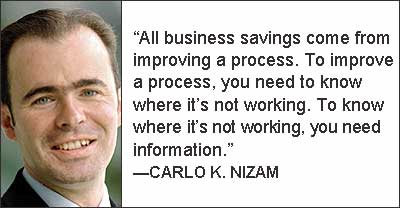Oct 01, 2007One of the most closely guarded secrets about the Airbus A380—the 525-passenger airplane dubbed "Superjumbo"—is how the jet airplane maker is going to customize the cabin for each airline. Air France, Emirates Airlines, Qantas, Singapore Airlines and others awaiting orders for the double-decker, four-engine giant have each asked Airbus to design the cabin differently, because they have their own ideas about which features—from the configuration of first-class seats to the size of overhead bins and entertainment options—will woo passengers.
Another closely guarded secret has been how Airbus plans to use radio frequency identification technology. While rival Boeing has announced that it wants suppliers to RFID-tag some 2,000 different parts for its upcoming 787 Dreamliner airplane, Airbus officials have been relatively quiet about their plans—that is, until the company invited RFID journal to visit the A380 final assembly plant in Hamburg, Germany, this summer and witness firsthand some of its RFID deployments and pilots.
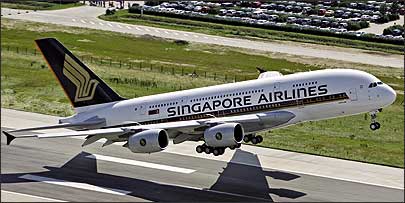
"Why has Airbus taken so long to talk?" asks Carlo K. Nizam, head of value-chain visibility and RFID for Airbus. "There are a number of reasons. First, there is a lot of hype with RFID, and we needed to separate the facts from fiction. Second, we have a very unique position of influence between our suppliers and customers—when Airbus does something, it is felt across the entire industry. Third, given that RFID represents such a rare opportunity to enable real business savings for everyone, it was important to take the time to focus on our airline customers, suppliers and industrial partners and listen to their ideas."
The fact is that RFID is helping to ensure that the 800 containers of parts needed to build each cabin get to the right place at the right time. Those parts have to be installed in sequence. If one important piece is missing, it could impact production. The first A380 is to be delivered to Singapore Airlines in October, and Airbus plans to ramp up production next year to reach a rate of four A380s a month by 2010.
Airbus built a huge hangar—it's five stories high and a quarter-mile long to accommodate up to four A380s—in Hamburg just for the installation of the A380 cabins. The size and scope of the parts-tracking operation there is indicative of Airbus' grand vision for using RFID. The company has embarked on an ambitious three-phase program to improve business processes and provide real-time automated visibility across its entire value chain of operations. It's the end result of a two-and-a-half year examination of how RFID could help the pan-European corporate giant streamline processes, cut out paperwork, move to a just-in-time approach to deliveries, optimize inventory levels and ultimately reduce costs. To understand Airbus' approach to RFID, it's important to understand the company's history.
Airbus is trying to encourage its suppliers and customers to consider the benefits of RFID by demonstrating how it is using the technology to see results in its own business. "We want to encourage all the players to join in the party," says Nizam. "It is in everyone's interests to reduce costs."
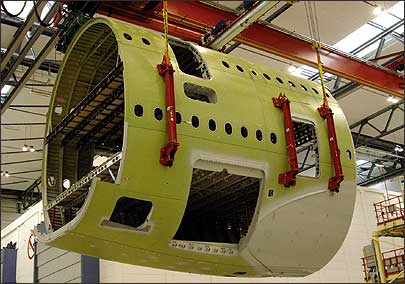
RFID has started to pay off for Airbus. Since 2006, when the company started its phase-one deployment, it has saved millions of euros each year by cutting process cycle times, eliminating paperwork and reducing inventory. "We have been very conservative in our approach and only considered tangible, hard and measurable savings," says Nizam. "Even so, the vast majority of the projects have ROIs within a year and the remainder within 18 months."
Phase One: Supply Chain, Warehouse Logistics and Distribution
Airbus made a conscious decision to initially focus on RFID applications that could provide important and quick wins, to help improve its business operations and build momentum for the technology. It identified streamlining its supply-chain tracking capabilities, and warehouse logistics and distribution processes. To that end, the first phase of the company's RFID program, begun in 2006, consisted of a two-pronged pilot to track parts through the supply chain to warehouses and onto assembly plants.
In the first pilot, which took place last year, two suppliers attached RFID-enhanced shipping labels to delivery boxes, which were sent to a third-party logistics company, Mazeres Aviation, located in Toulouse, France. The suppliers that participated in the pilot were also both headquartered in France—Messier Bugatti, which supplies landing gear components, such as wheels, brakes and tire pressure monitoring equipment, and Michelin, which supplies 22 tires for each A380.
For the second RFID pilot, Airbus moved from Toulouse to Hamburg, where it's assembling the A380 cabins. The five-story hangar is open on one side, to accommodate the plane's enormous tail fin and wingspan. The other side has stairs and elevators to take workers and parts to the cabin. In order for Airbus to keep to its production schedule, it is essential that the right parts be delivered in the right order to the right dock door of the building—and ultimately to the right floor—on time.
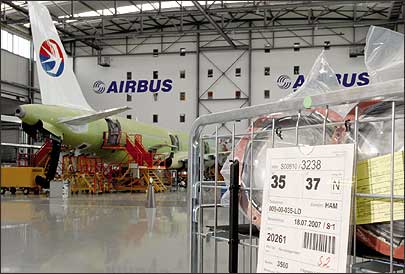
During the pilot, Airbus fitted reusable containers for the A380 final cabin assembly line with three-inch-long, plastic-coated UHF RFID tags. The tagged containers are filled with cabin parts at a third-party logistics provider, and a cabin-parts supplier, both in Germany; they coordinate information about parts from bar-code readings with the container tag into an Airbus database. The tagged containers are transported to the Hamburg facility and read by interrogators upon arrival at a loading dock. They are also read upon leaving the elevator at each floor, and after they have been emptied and leave the building to be refilled again. If a container arrives at the wrong loading dock or is wheeled off the wrong elevator floor, an alarm light is triggered.
"This not only helps to reduce inventory on the floor, but it checks that everything is delivered to the right location," says Sven Kedor, who is in charge of IT systems on the A380 assembly line in Hamburg. "The logistics group can look at the lights, and they have a control screen so they are able to see that the containers are delivered in sequence and on time."
The RFID automated container-tracking process is now part of normal business operations at the Hamburg facility, with 3,000 RFID-tagged containers read by 40 interrogators located in strategic points inside the five-story building. Thanks to improved visibility and just-in-time deliveries to the assembly, Airbus has reduced by 8 percent the number of containers needed, compared with the amount needed when using a manual-tracking process. The success of the automated container-tracking process has led Airbus to apply the same RFID process at the A320-family assembly line in Hamburg.
Nizam says that just as Airbus pioneered the "fly-by-wire" concept of a digitally managed flight-control system, which is now an industry standard, the company wants to use visibility technologies such as RFID to build a "fly-by-wire" digital view of the supply chain and its business operations.
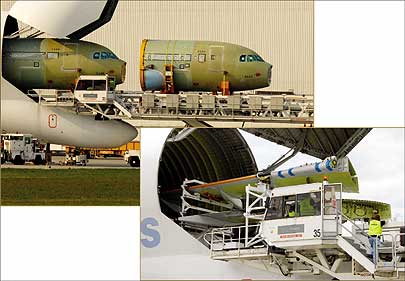
Phase Two: Global Transport, Manufacturing and Assembly
In February, Airbus started the second phase of its RFID program: to better understand RFID's potential in a variety of other facets of manufacturing and assembly. The company has identified several different target areas. Some projects are in the planning stage. Others are in pilots, such as the one to coordinate the logistics of large aircraft sections that contain hundreds of thousands of different parts—not only for the A380 but also the smaller A320 family, larger A330s/A340s, and the A400M military lifter—through a global supply chain.
Many parts are assembled into larger components at the company's 16 different facilities throughout Europe: The wings are assembled in the United Kingdom; the horizontal tails in Spain; the nose and center fuselage in France; and the forward and aft fuselage and vertical tails in Germany. All the oversize parts need to be transported to the final assembly lines in France and Germany, so Airbus developed an aircraft to transport them. The plane—called the Airbus Beluga because it looks like a whale—opens from the front to allow wings, fuselage sections and tail planes to be loaded and unloaded. The company currently operates five Beluga aircraft, each of which sometimes makes three to five stops per day across 13 different locations.
The parts are loaded onto the Beluga in jigs—very large and expensive transport frames that are specific to each type of part it transports. Empty jigs are supposed to be returned to the site that produces that section of the aircraft so that the next section can be readied for transport. The problem is that Airbus did not have an accurate way to track and trace the jigs, relying on workers to telephone, e-mail or walk over to the jig storage area to determine their location. If a part is delayed or a jig is missing, Beluga flights can be delayed and that can throw a wrench into the production schedule.
Starting in September, the pilot will become operational and the RFID tags will be read whenever the jigs are moved by cargo loaders; the data will be communicated over a wireless network to workers in a nearby building. The workers will operate a database that monitors jig status, which eventually will be shared with other Beluga stations.
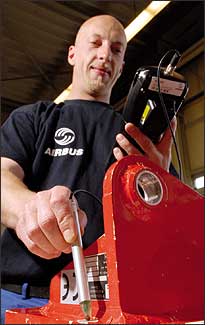
"We can capture direction—in and out," says Thomas Hebisch, IS project leader for the Beluga RFID pilot. "That gives us an overview—a clear situation—whether the jig is available, has been unloaded or loaded or is in transport."
The pilot will run through the end of 2007. "If the results are positive and in line with expectations," says Nizam, "a decision will be considered at the beginning of next year whether to expand this scalable solution across the global Airbus transport network."
Another phase-two pilot, underway at the Airbus assembly plant in Bremen, Germany, involves using RFID to track sheet metal through the cutting, bending and processing into airplane parts. "Each piece of sheet metal is processed about 10 times," says Patrick J. Sweeney II, CEO and president of ODIN Technologies of Reston, Va., Airbus' hardware integration partner. "Between each process, there has to be a confirmation of what took place." This confirmation is performed by manually scanning bar codes on a paper work order. When you add it all up, says Airbus, that's about 1.5 million times per year that a bar code is manually scanned to say that a stage of a process is complete.
Among the pilots in the planning process is an application to track tools—from those used in production to those used to test landing-gear systems. "What is important is that the tools are in the right place at the right time," says Nizam, "so if it moves, it needs to be tracked." The RFID-tracking application may also be able to help Airbus calibrate tools when they need it rather than on a fixed schedule, saving time and money.
The company also believes that it might be able to use RFID to replace more paper processes. When Airbus builds a plane, every part that goes into it needs to be traced. Airbus tracks that information on paper, but that is going to get more difficult as production rates ramp up. The company is planning to launch a series of industrial RFID pilots involving putting tags on the parts themselves. "We think that will help increase the efficiency of the data-entry process," says Nizam, "as well as the integrity, accuracy and robustness of the data itself."
Phase Three: In-Service and Support Operations
While Airbus' chief rival, Boeing, announced back in 2005 that it was beginning a parts-marking initiative on production of its upcoming Dreamliner planes, Airbus is not yet ready to make a similar commitment. "The secret to making RFID add value is in making sure that the people, process and the technology all fit together to provide a net benefit," Nizam says. "If we are going to offer something new to our customers, all those things need to fit together and work right the first time. Today, they all still need more work to get them to a level of maturity that would be acceptable by airline customers."
Airbus is looking at other in-service processes that could be enabled by RFID. "The important point is that the airline doesn't want to go to an Airbus A380 and a Boeing 747—the A380 being the better plane, of course—and have a different infrastructure to cope with," Nizam says. "They would like to have an interoperable enabler based on open standards. That requires Airbus and Boeing to settle their differences and come up with a common solution—not just for Airbus and Boeing, but for the entire industry."
But how the companies use those standards and offer them to airlines and suppliers is competitive. Airbus has not taken a position yet on what type of RFID technology, if any, it will use on legacy airplanes or even the A380 or its A350. "We don't believe in a one-size-fits-all solution," Nizam says. The company says that there are some processes for airline maintenance and operation support where mechanics will need a very short distance to work with; if they are using a long-range UHF reader, they will collect a lot more information than they want.
While Airbus officials don't believe a parts-marking solution is ready for flight, the company has been running tests both in the lab and on a number of Airbus aircraft. The company also believes an in-service RFID part-marking solution can help its airline customers and suppliers gain efficiencies in operational, maintenance and repair, and payload-tracking processes.
In March 2006, Airbus held a two-day focus group for customers and suppliers, to develop plans for testing these in-service RFID processes. "Who knows the business better than our customers?" Nizam says. With customer input, Airbus will undertake industrial in-service trials with airlines and suppliers for a selection of processes covering warehouse logistics, configuration management and maintenance, repair shop optimization and payload tracking. The trials are due to start in early 2008.
In the meantime, Airbus is satisfied that RFID can have positive financial results in its own business. "All business savings come from improving a process. To improve a process, you need to know where it's not working," Nizam says. "To know where it's not working, you need information. We call that visibility. Visibility is the foundation for all process improvements and, therefore, the foundation for all savings. What does RFID do? It helps you improve visibility."
Airbus, which is owned by the European Aeronautic Defence and Space Company (EADS), was formed as a consortium of several European aerospace companies in the early 1970s to compete with large U.S. aerospace companies, such as Boeing. Original consortium members were France's Aerospatiale, Germany's Deutsche Airbus and Spain's CASA. British Aerospace joined later. Each of the partners operated as national companies and assumed responsibility for producing different parts of the aircraft that were transported to Airbus headquarters in Toulouse, France, for final assembly. It wasn't until 2001 that the consortium members became one fully integrated company, and that coincided with the development of the A380 jumbo passenger airplane.
In the years since, Airbus has undertaken an aggressive process and systems transformation to better integrate the company; previously, each member had its own logistics operations and supply-chain systems, for instance. RFID is seen as a cornerstone of this transformation, because it's all about changing processes to make improvements. Airbus started testing RFID in the 1990s, but like many corporate giants, the company didn't have a coordinated plan for using the technology across different divisions. As recently as two-and-a-half years ago, there were 10 to 15 different RFID projects under discussion in various business units at Airbus.
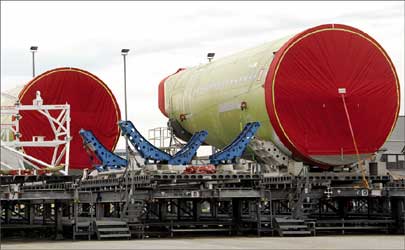
"The risk was that we were all going to duplicate activities, choose different suppliers, different solutions and—at the time—even different standards," says Carlo K. Nizam, head of value-chain visibility and RFID for Airbus. Instead, those interested in RFID started contacting one another. "We all realized there was an advantage if we all collaborated together," he says, "and shared what we were doing."
Today, Airbus' value-chain visibility and RFID program is steered by a 10-member committee made up of vice presidents from customer services, marketing, operations, engineering, procurement and other units in the company that reviews all business cases before approving projects. The program's goal is to enable business savings across the value chain through real-time visibility. It is developing various RFID applications—some in conjunction with the use of bar codes and even optical character recognition technology. All the solutions are scalable and can be used in different divisions and locations throughout Airbus, perhaps even at parent company EADS. Airbus is also working with its technology suppliers to offer technology solutions and assistance to interested suppliers and customers.
ODIN Technologies of Reston, Va., Airbus' hardware integration partner, has agreed to make its services and performance optimization software available to Airbus customers and suppliers. "One of the key things about Airbus is that it's a critical catalyst for the industry," says Patrick J. Sweeney II, CEO and president of ODIN, which specializes in RFID installations for large, global supply chains. "Just as the U.S. Department of Defense did in defense, Wal-Mart did in retail and Best Buy is doing in consumer electronics, Airbus has made a distinct competitive move…that can be seen as a critical tipping point in the aerospace industry."

